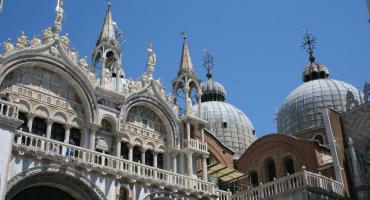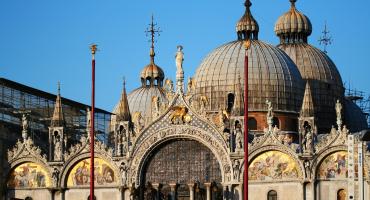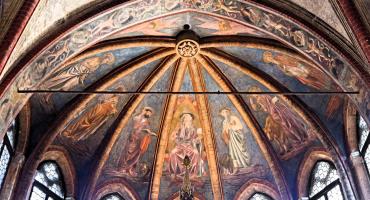Fulcrum of the city’s religious and public life, place where all the Doges were legitimize, this church is one of the main symbols of Venice and of its history. It was built in the 9th century to treasure the remains of Evangelist Marc, patron saint of the city stolen from Alexandria in 828, it is a magnificent example of the Romanesque-Byzantine style.
In its complex and organized structure, the church reflects the different periods of the construction, which have added signs of Gothic and sixteenth century works to the earlier Romanesque-Byzantine elements.
Refurbished many times, the church acquired the typical features of Byzantine churches, with a big central dome and hemispherical domes on top of small globe ones.
Its five gates façade is decorated with precious marbles and mosaics and divided in two by a terrace, on which the Four golden copper Horses are; they have been sent from Constantinople to the Doge Enrico Dandolo in 1204 and are the copies of the original ones guarded inside.
In the hall before the entrance of the church, the marbled mosaic floor (11th - 12th century). The walls have many marbles and columns, vaults and little domes shines with Venetian-Byzantine mosaics of the 12th-13th century. Three gates with bronze doorknockers of the 11th – 13th century give access to the church.
The impressive interior is typically Byzantine, Greek plain with three naves divided by arcades on top of which are the matronea; mighty arches support the five mosaic domes.
The bottom golden mosaics decorating the upper walls and the domes represent one of the main treasures of the Basilica. Decorated by Venetian and Byzantine artists of the 12th and 14th century, the mosaics were partly remade during the 16th and 17th century by Tiziano, Tintoretto, Veronese and others.
The presbytery is raised on the crypt and separated by a wall of marble icons (iconostasi), on top of statue by Dalle Masegne (1396). Four alabaster columns hold up the main altar, which contains the remains of Saint Mark. On the back is the famous Pala D’Oro, an enamel and gems studded Byzantine-Venetian goldworking masterpiece (10th-15th century). The bell tower beside the Basilica worked once as lighthouse for sailors. At its foot, on the apse left recess is the bronze door of the sacristy, the last work by Jacopo Sansovino (1546-69).
Useful information:
Opening hours:
BASILICA
- from Monday to Saturday: 9.30 am - 5.15 pm
- Sunday: 2 pm - 5.15 pm
CAMPANILE
SUMMER TIMES:
everday, from 9.30 am to 9.15 pm
WINTER TIMES:
-everyday: from 9.30 am to 7.15 pm
Prices:
Tickets can only be purchased from the official Basilica website: https://basilicasanmarco.skiperformance.com/it/negozio#/it/acquista?skug...
1) Admission Ticket St. Mark's Basilica: Full price: €10.00 // Reduced: €5.00 // Family (3 adults): €10.00
2) Admission Ticket St. Mark's Basilica + Museum and Horses' Loggia: Full price: €20.00 // Reduced: €10.00 // Family (3 adults): €20.00
3) Admission Ticket Museum and Horses' Loggia Only: Full price: €14.00 // Reduced: €7.00 // Family (3 adults): €14.00 *Open only on Sunday mornings, from 9:30 AM to 1:30 PM*
4) Admission Ticket Bell Tower : Full price: €15.00 // Reduced: €7.50 // Family: €15.00
5) Admission Ticket St. Mark's Basilica + Pala d'Oro: Full price: €20.00 // Reduced: €10.00 // Family (3 adults): €20.00 *Closed on Sunday mornings*
6) Admission Ticket St. Mark's Basilica + Pala d'Oro + Museum and Horses' Loggia: Full price: €30.00 // Reduced: €15.00 // Family (3 adults): €30.00 *Last admission at 3:00 PM*
Contacts:
Tel: +39 041 2708311
E-mail: info@procuratoriasanmarco.it
For any further information, please check on website: www.basilicasanmarco.it
Address: Piazza S.Marco, 1 San Marco cap 30124 - Venezia
How to get there: water-bus, stop "S. Zaccaria"
Copyright Notice: these images have been sourced online. If you are the copyright holder and wish for it to be removed, please contact us.



